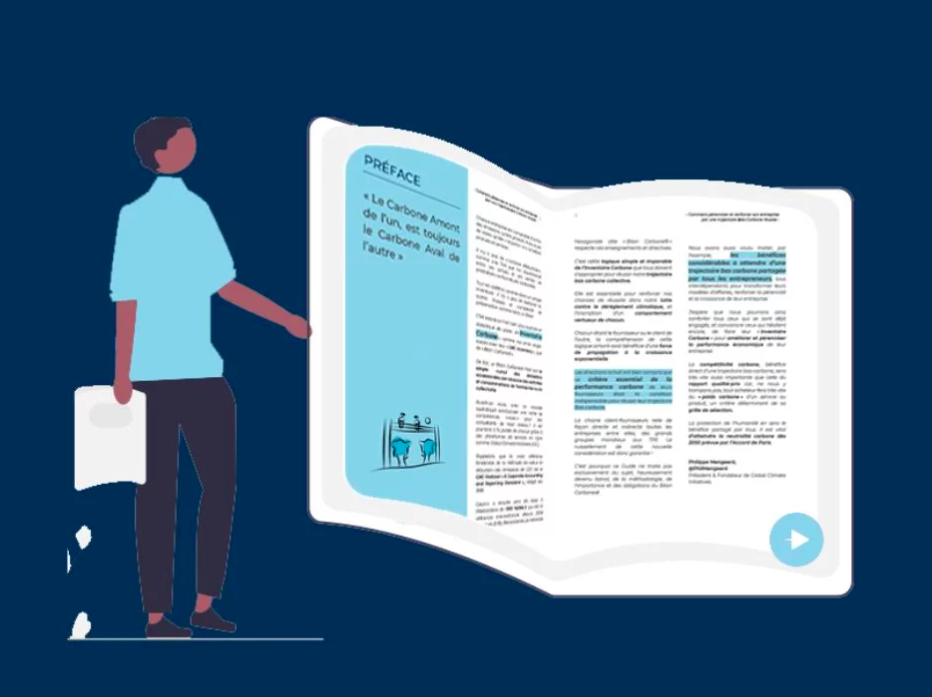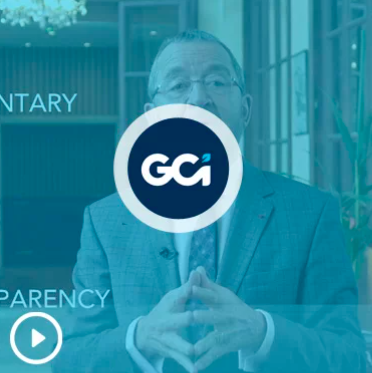GHG balance by sector
How do I calculate my GHG footprint?
Offset your company's carbon footprint
Reduce and manage your company's carbon footprint
Committing to a decarbonization strategy?

Dec 3, 2025 |
GHG balance, How do I calculate my GHG balance?, Definitions, Calculating your GHG balance
Faced with BEGES regulations, how to turn constraints into opportunities
Decarbo'Solution® transforms purchases, transition plans, and calls for tenders into measurable levers for low-carbon performance, based on reliable data and supplier commitment.

Nov 26, 2025 |
After the carbon footprint assessment, GHG assessment, How to calculate my GHG assessment, Offsetting your organization's carbon footprint, Definitions, Low-carbon strategy
Sustainable development explained simply
Sustainable development offers a vision of progress that meets current needs while preserving those of future generations. Born out of the Brundtland Report, it now guides public policy and corporate initiatives.

Nov 18, 2025 |
GHG Footprint, How to calculate my GHG Footprint, Definitions
Why does methane accelerate global warming?
Methane is a powerful greenhouse gas, more than 80 times more potent than CO₂ over a 20-year period. Understanding its origins and effects helps identify the most effective ways to slow global warming.

October 23, 2025 |
Bilan GES, Bilan GES par secteur, How do I calculate my Bilan GES?
Data Center Pollution: Understanding and Reducing the Carbon Footprint of Digital Technology
Data centers, the pillars of the digital world, consume enormous amounts of energy and account for a growing share of global emissions. Discover how to measure, understand, and reduce their carbon footprint to build a more sustainable digital world.

October 22, 2025 |
Bilan GES, Bilan GES par secteur, How do I calculate my Bilan GES?
Understanding GHG emissions related to real estate
The real estate sector accounts for a significant portion of GHG emissions. Discover how to measure and reduce them with GCI's Decarbo'Solution®.

October 17, 2025 |
How do I calculate my GHG footprint, How do I do my GHG footprint?
Evaluating suppliers on CSR: pitfalls to avoid
Assessing suppliers on CSR is not limited to a simple questionnaire. Discover how to avoid the pitfalls of declarative statements and transform extra-financial analysis into a lever for performance and decarbonization.

October 16, 2025 |
How do I calculate my GHG footprint, How do I do my GHG footprint?
Post-carbon footprint assessment action plan: avoiding the drawer effect
A carbon footprint assessment only makes sense if it leads to a concrete action plan. Discover how to transform your emissions data into strategic levers with a clear roadmap that is monitored and aligned with your low-carbon transition goals.

October 15, 2025 |
How do I calculate my GHG balance sheet?, Definitions, Low-carbon strategy
Building a sustainable supply chain: where to start when you're an SME?
Building a sustainable supply chain enables SMEs to combine economic performance, environmental responsibility, and resilience. By incorporating CSR and carbon criteria into their purchasing, they reduce their ecological footprint while strengthening the trust of their partners and customers.

October 13, 2025 |
How do I calculate my GHG balance sheet?, Definitions, Low-carbon strategy
Everything you need to know about the SRI label
The SRI label certifies investment funds that incorporate environmental, social, and governance (ESG) criteria. It guarantees more ethical and transparent management, while directing capital towards companies committed to sustainable development.

October 7, 2025 |
GHG assessment, How to calculate my GHG assessment, Low-carbon strategy
What is the Product Environmental Footprint (PEF)?
The Product Environmental Footprint (PEF) is a European method that measures the environmental impact of a product throughout its life cycle. It helps companies assess, compare, and improve the sustainability of their products according to reliable and harmonized criteria.

October 6, 2025 |
GHG assessment, How to calculate my GHG assessment, Low-carbon strategy
Definition and objectives of the QSE approach
The QSE (Quality, Safety, Environment) approach helps companies improve their performance, enhance workplace safety, and reduce their environmental impact, while promoting customer satisfaction and sustainable development.

Sep 11, 2025 |
GHG balance, How to calculate my GHG balance, Doing your GHG balance
The decarbonization strategy is not just for large companies
The low-carbon transition is no longer the sole preserve of large corporations. For SMEs and microbusinesses, it is a lever for competitiveness, resilience, and attractiveness, thanks to simple and progressive solutions such as Decarbo'Solution®.

Sep 10, 2025 |
Bilan GES, Bilan GES par secteur, How do I calculate my Bilan GES?
Everything you need to know about environmental analysis according to ISO 14001
ISO 14001 provides companies with a recognized framework for analyzing, reducing, and managing their environmental impacts, while strengthening competitiveness and credibility.

Sep 2, 2025 |
GHG balance, How to calculate my GHG balance, Doing your GHG balance
Are your suppliers aligned with your eco-responsible commitments? How can you find out?
Organic products, sustainable packaging... but are your suppliers truly eco-friendly? This article provides you with the right criteria to check and take action.

July 24, 2025 |
GHG balance, How to calculate my GHG balance, Doing your GHG balance
Carbon data: where to find the right emission factors for your scope 3
Finding the right emission factors for scope 3 is essential for a reliable carbon footprint: public databases (ADEME, Defra, EcoInvent), sector-specific data and supplier information must all be cross-referenced, while adapting choices to the sector, level of detail and reality of the company in order to effectively manage its low-carbon transition.

July 22, 2025 |
GHG balance, How to calculate my GHG balance, Doing your GHG balance
Why decarbonization support changes everything
Structuring a low-carbon trajectory is now essential to remain competitive: thanks to expert support, tailored tools and the involvement of the entire value chain, companies can transform their carbon footprint into a genuine lever for performance, attractiveness and sustainable differentiation.

July 7, 2025 |
GHG assessment, How to calculate my GHG assessment, Low-carbon strategy
No greenwashing: setting and managing credible corporate climate objectives
Faced with the urgency of climate change, companies need to prove their commitment with credible, measurable objectives. Out with greenwashing: in with GHG assessments, rigorous transition plans, and actions in line with ADEME requirements and French environmental standards.

July 2, 2025 |
GHG Footprint, How to calculate my GHG Footprint, Definitions
E-mail pollution underestimated
Email-related digital pollution is a major environmental issue for companies, impacting both their carbon footprint and their CSR policy. Controlling the impact of email and adopting responsible digital practices can significantly reduce an organization's ecological footprint.

June 30, 2025 |
GHG Footprint, How to calculate my GHG Footprint, Definitions
What you need to know about environmental labelling
Find out what you need to know about environmental labelling: an essential tool for assessing the environmental impact of products and guiding consumers towards more responsible choices, supported by the French Climate Law and European initiatives.

June 27, 2025 |
GHG assessment, How to calculate my GHG assessment, Low-carbon strategy
8 key actions to become an eco-responsible company
Becoming an eco-responsible company means taking concrete action: eco-designing products, reducing energy and waste, involving teams and choosing responsible partners. Discover 8 key actions to start this sustainable transition.

June 19, 2025 |
GHG Footprint, How to calculate my GHG Footprint, Definitions
Everything you need to know about Corporate Social Responsibility (CSR)
Organizational Social Responsibility (OSR) refers to the voluntary commitments made by any structure - company, association or administration - to integrate environmental, social and governance issues into its activities.

June 19, 2025 |
GHG Footprint, How to calculate my GHG Footprint, Definitions
Why are regulations reinforcing the importance of carbon footprints?
Carbon footprinting is becoming a strategic lever for managing the low-carbon transition and meeting new regulatory and market requirements.

June 19, 2025 |
GHG Footprint, How to calculate my GHG Footprint, Definitions
What is carbon debt?
Carbon debt measures the extent to which our greenhouse gas emissions exceed climate targets, making transition efforts more costly and urgent. For companies, this indicator is becoming an essential strategic lever for steering low-carbon transformation, limiting risks and creating sustainable value.

June 12, 2025 |
GHG Footprint, How to calculate my GHG Footprint, Definitions
The AGEC law and its changes for 2025: a quantified impact towards a circular economy
In 2025, the AGEC law takes a new step forward by imposing reinforced obligations in terms of waste reduction, reuse and repair, with a major impact on businesses and local authorities. These regulatory changes also offer concrete opportunities to innovate, adapt business models and accelerate the transition to a circular, low-carbon economy.

June 11, 2025 |
GHG Footprint, How to calculate my GHG Footprint, Definitions
Ecowatt: how does it work and why should you care?
Ecowatt is the weather forecast for electricity: a simple tool for avoiding blackouts and consuming at the right time. Thanks to clear signals, everyone can take action to ensure a more stable network. Businesses and citizens, adopt the right gestures with GCI.

June 11, 2025 |
GHG assessment, How to calculate my GHG assessment, Definitions, Committing to a decarbonization strategy?
The concept of sustainability explained simply
Sustainability means living and producing without compromising tomorrow. A balance between environment, economy and society, for a viable future.

May 27, 2025 |
Bilan GES, Bilan GES par secteur, How do I calculate my Bilan GES?
GLEC: Your strategic partner for more responsible logistics
The GLEC Framework, aligned with international standards such as the GHG Protocol and ISO 14083, provides a structured reference framework for measuring, reporting and reducing greenhouse gas emissions in the often fragmented and complex logistics sector.

May 22, 2025 |
Bilan GES, How do I calculate my Bilan GES?
Diag Décarbon'Action is back: it's up to you!
Good news: the Diag Décarbon'Action is back! Co-funded by Bpifrance and ADEME, this scheme enables SMEs and ETIs to structure their low-carbon strategy thanks to expert support and a subsidy of up to 60%.

May 21, 2025 |
Bilan GES, How do I calculate my Bilan GES?
CO₂e calculation: a strategic lever for a successful environmental transition
Calculating your tons of CO ₂e is much more than a regulatory obligation: it's a strategic lever for boosting performance, anticipating risks and strengthening your credibility.

May 15, 2025 |
GHG Footprint, How to calculate my GHG Footprint, Definitions, Expertise
Greenwashing: A complete guide to understanding and avoiding greenwashing
To avoid falling into the greenwashing trap, this comprehensive guide will help you understand the mechanisms of greenwashing and make more informed choices.

May 7, 2025 |
Bilan GES, Bilan GES par secteur, How do I calculate my Bilan GES?
How can CO2 emissions from road transport be reduced?
Road transport accounts for almost a third of CO ₂ emissions in France. Faced with the climate emergency, concrete levers exist to rethink logistics and reduce carbon impact.

May 7, 2025 |
Bilan GES, Bilan GES par secteur, How do I calculate my Bilan GES?
Combining economic and environmental performance in the air transport sector
Maritime transport and the climate challenge: technologies, regulations and strategies to reduce emissions without sacrificing competitiveness. An overview of the keys to sailing towards a sustainable future.

May 5, 2025 |
Bilan GES, Bilan GES par secteur, How do I calculate my Bilan GES?
Reconciling CO₂ emissions reduction and competitiveness in shipping
Maritime transport and the climate challenge: technologies, regulations and strategies to reduce emissions without sacrificing competitiveness. An overview of the keys to sailing towards a sustainable future.

May 5, 2025 |
How to calculate my GHG footprint, Definitions, Expertise
Scope 2 and Scope 3: understanding indirect emissions and their impact on low-carbon strategy
Understanding scopes 2 and 3 widens the scope for action to truly reduce a company's carbon footprint.

Apr 30, 2025 |
Bilan GES, How to calculate my Bilan GES, Expertise, Low-carbon strategy
How does the Climate Fresco transform participants' ecological awareness?
Awareness-raising, education and customized support enable companies to mobilize their employees, strengthen their CSR culture and make the environmental transition a shared, meaningful project.

Apr 23, 2025 |
GHG Footprint, How to calculate my GHG Footprint, Definitions
Carbon neutrality 2050: challenges, strategies and levers for a successful green transition
Achieving carbon neutrality - the Net Zero Initiative - is an unavoidable goal for preserving our climate, as the experts on the European Union's climate council emphasize.

Apr 23, 2025 |
Bilan GES, Bilan GES par secteur, How do I calculate my Bilan GES?
Reducing CO2e emissions in the transport sector: a necessity for companies
Transport is a major source of CO2e emissions: optimizing it means taking effective action for a more sustainable model.

Apr 22, 2025 |
Bilan GES, How do I calculate my Bilan GES?
How is carbon calculated?
Calculating your carbon footprint means understanding the impact of your activities on the environment. It is also a lever for action to reduce emissions and innovate sustainably.

Apr 11, 2025 |
GHG Footprint, How to calculate my GHG Footprint, Definitions
Everything you need to know about ISO 14 067?
Find out why controlling the carbon footprint of your products has become a strategic issue, and how ISO 14067 provides a reliable framework for meeting this challenge.

Apr 2, 2025 |
Bilan GES, How do I calculate my Bilan GES?
Keeping your transport footprint under control with the TK'Blue solution!
Optimize your transport carbon footprint with TK'Blue! This reporting tool helps you measure, analyze and reduce GHG emissions. Integrated with GCI, it facilitates compliance and enhances your CSR commitment.

Mar 13, 2025 |
GHG Footprint, How to calculate my GHG Footprint, Definitions
GHG assessment: what next? Examples from our customers
Carrying out a GHG assessment is a key step for any company wishing to understand and reduce its environmental impact. But once the calculation is complete, the key question is: what next?

Mar 12, 2025 |
GHG assessment, How to calculate my GHG assessment, Expertise, Doing your GHG assessment
CSR: a strategic lever for a more responsible and efficient company
An effective CSR approach improves performance and enhances attractiveness to consumers, suppliers and investors.

Mar 10, 2025 |
GHG Footprint, How to calculate my GHG Footprint, Definitions
IPCC report: Issues, findings and actions for companies
The latest IPCC report highlights the sectors most affected and the importance of rapid transformation.

Mar 5, 2025 |
Bilan GES, How do I calculate my Bilan GES?
Eco-design: a key lever for responsible, sustainable innovation
By 2020, 75% of companies had already integrated eco-design into their strategy, according to the ADEME barometer. Are you ready to take the plunge?

Feb 21, 2025 |
Bilan GES, How do I calculate my Bilan GES?
Why can't companies' carbon footprints be compared?
Comparing GHG balances between companies can be hazardous and counter-productive.

Feb 19, 2025 |
Bilan GES, How do I calculate my Bilan GES?
Greenwashing: deciphering a controversial practice and how to protect against it
Did you know that 53% of corporate environmental claims are vague, misleading or unfounded, and that 40% have no supporting evidence?

Feb 14, 2025 |
Bilan GES, How do I calculate my Bilan GES?
Imagine a low-carbon future: A world in 2050 with a carbon footprint in line with the Paris Agreements
Reducing our carbon footprint is an urgent necessity, and although French emissions have fallen, a profound societal transformation is essential to achieve a low-carbon future by 2050.

Jan 30, 2025 |
Bilan GES, Bilan GES par secteur, How do I calculate my Bilan GES?
Bilan GES d'un événement sportif: how to reduce the ecological footprint of a major gathering?
Organizing a sporting event, whether it's the Olympic Games, national competitions or a simple local tournament, raises major challenges in terms of environmental impact.

Jan 20, 2025 |
GHG assessment, GHG assessment by sector, How to calculate my GHG assessment, Definitions, Expertise
Scope 1 and 2: understanding and reducing your direct and indirect energy-related emissions
Focus on scopes 1 and 2: These categories cover direct emissions from the company's activities (scope 1) and indirect emissions linked to energy consumption (scope 2).

Jan 16, 2025 |
Bilan GES, Bilan GES par secteur, How do I calculate my Bilan GES?
GHG assessment for a festival: how to organize an eco-responsible cultural event?
Organizing an eco-responsible festival requires a precise GHG balance sheet. Reducing carbon emissions from travel, optimizing energy use and better managing waste: concrete solutions for a reduced impact and a committed audience.

Jan 9, 2025 |
Bilan GES, Bilan GES par secteur, How do I calculate my Bilan GES?
Calculating a website's GHG footprint: why and how can companies take action?
Digital technology already accounts for almost 4% of global CO ₂ emissions. This reality, often underestimated, is growing with the multiplication of digital sites and uses.

Jan 2, 2025 |
Bilan GES, Bilan GES par secteur, How do I calculate my Bilan GES?
CO2 emissions by mode of transport: how can companies reduce their impact?
Transport accounts for a quarter of global emissions. To reduce their carbon footprint, companies can give preference to rail or adopt electric fleets.

Dec 23, 2024 |
Bilan GES, Bilan GES par secteur, How do I calculate my Bilan GES?
Why and how to reduce the environmental impact of a business event?
Organizing a business event generates a carbon footprint. Measuring these emissions is key to acting responsibly and aligning your CSR commitments.

Dec 2, 2024 |
GHG assessment, How to calculate my GHG assessment, Expertise
Net Zero Initiative: a single repository for a collective contribution to Net Zero
The Net Zero Initiative (NZI) aims to structure and harmonize companies' moves towards carbon neutrality.

Nov 28, 2024 |
Bilan GES, Bilan GES par secteur, How do I calculate my Bilan GES?
Bilan GES des Entreprises Publiques : Un Guide Essentiel vers la Transition Écologique
Why is a GHG assessment essential for public-sector companies? Find out how this strategic tool can transform your ecological commitments into concrete action.

Nov 21, 2024 |
GHG assessment, How to calculate my GHG assessment, Doing your GHG assessment, Low-carbon strategy
Beyond carbon footprints: ACT methodology for sustainable corporate transition
Carbon footprinting is a key, but insufficient, step towards sustainable transition. The ACT methodology transforms these assessments into actions in line with the Paris Agreement.

June 3, 2024 |
How do I calculate my GHG footprint?
The role of emission factors in a GHG assessment
Emission factors play a key role in producing a GHG balance. It is important to choose them carefully and to know where to find them.

Apr 18, 2024 |
GHG balance, How to calculate my GHG balance, Doing your GHG balance
Reduce the impact on biodiversity by calculating a GHG inventory
Explore the crucial link between reducing companies' carbon footprints and preserving biodiversity.

Apr 17, 2024 |
GHG balance, How to calculate my GHG balance, Doing your GHG balance
The benefits of Bilan Carbone® online
Discover the advantages of online tools for carrying out greenhouse gas emissions assessments!

July 19, 2023 |
Bilan GES, How do I calculate my Bilan GES?
Measure and reduce my carbon footprint with GCI
It is essential that companies have a reliable solution for calculating their carbon footprint in order to play a key role in reducing GHG emissions.

May 30, 2023 |
GHG balance, How to calculate my GHG balance, Doing your GHG balance
A practical guide to calculating a product's carbon footprint using LCA
LCA is an essential asset for companies wishing to reduce their carbon footprint and remain competitive in the marketplace.

May 12, 2023 |
Bilan GES, How do I calculate my Bilan GES?
Why and how can we improve our GHG inventory thanks to the commitment of our suppliers?
There is an essential lever for decarbonizing its activity: the involvement of suppliers, who represent 50 to 90% of Scope 3 emissions.

Apr 28, 2023 |
Bilan GES, How do I calculate my Bilan GES?
Carbon footprinting, the first step towards measuring and improving your Carbon Competitiveness®.
The carbon footprint is becoming the mandatory indicator for the ecological transition and the sustainability of all companies.

Sep 29, 2022 |
How do I calculate my GHG footprint, How do I do my GHG footprint?
Obligations of the Carbon Inventory... but an opportunity to reduce your emissions!
Since July 1, 2022, the government's "transition plan" has been stricter. Companies are obliged to calculate their carbon footprint and establish a low-carbon trajectory by considering the *global* volume of their GHG emissions. Companies must also demonstrate the coherence of their long-term low-carbon trajectory.

Sep 18, 2022 |
How to calculate my GHG footprint, Low-carbon strategy
CSR and SDO: what are they?
Corporate Social Responsibility: CSR and Sustainable Development Goals: SDGs - two acronyms to know

Sep 12, 2022 |
How do I calculate my GHG footprint, How do I do my GHG footprint?
Improving a company's carbon footprint through the proper use of the circular economy
Since the Paris Agreement, countries and companies have agreed on the importance of acting against global warming, i.e. acting on their carbon footprint by limiting their GHG emissions. Solutions have been developed to help companies commit and accelerate their ecological transition. To facilitate the implementation of these reduction solutions, the realization of a GHG assessment is the ideal solution.

August 5, 2022 |
How do I calculate my GHG footprint, How do I do my GHG footprint?
One, two, three... and the GHG emissions will be well calculated!... And reduced!!! Focus on the integration of the 3 scopes on the GCI platform.
The new decree of July 1, 2022, which imposes scope 3 and a reduction action plan, and the 2022 Finance Act, which requires most companies with more than 50 employees to also carry out a GHG assessment, albeit initially in a simplified form, confirm the growing regulatory pressure.

August 1, 2022 |
How to calculate my GHG footprint, Expertise
"Don't do my company's GHG assessment, teach me how to do it instead!"
A complete balance sheet is the inventory of GHG emissions through three categories, also called scopes. The objective is to categorize greenhouse gas emissions by item or by type of activity of a company. The integration of all these emissions in a GHG assessment allows a complete review and then, to engage solutions to reduce them.

July 27, 2022 |
How do I calculate my GHG footprint?
Carry out its GHG inventory® to respect the "tertiary decree
To improve the energy performance of existing buildings, the law goes further with the "tertiary decree", which is much more restrictive and monitored. The latter aims to accelerate the reduction of energy consumption in public and private buildings. Several solutions are outlined in the existing regulations.

July 11, 2022 |
How do I calculate my GHG footprint, How do I do my GHG footprint?
Publication of the July 1, 2022 decree on greenhouse gas emissions assessments: Scope 3 finally becomes mandatory!
Scope 3 covers all indirect greenhouse gas emissions associated with an organization's activity. It therefore represents many more GHG emissions than Scopes 1 and 2, which only account for direct and indirect energy-related emissions.

June 27, 2022 |
How do I calculate my GHG footprint?
A Low-Carbon trajectory: a must for the company's survival
GCI offers on its website a free downloadable guide "How to perpetuate and strengthen your company through a successful low-carbon trajectory", this guide has 3 objectives: to explain simply what a low-carbon assessment and strategy consists of, to demonstrate the opportunities for developing its performance, to present concrete examples

June 2, 2022 |
How do I calculate my GHG footprint?
Responsible purchasing must take into account the "carbon weight" of suppliers
The Purchasing function is at the heart of the company's operations. The implementation of responsible purchasing is an effective lever for implementing sustainable development and a policy of social responsibility (CSR) within the organization.

May 16, 2022 |
How to calculate my GHG footprint, Expertise
What is the Bilan Carbone (greenhouse gas emissions assessment)?
The carbon footprint calculates a company's total greenhouse gas emissions. Carbon dioxide, methane, nitrous oxide... emissions of several types of gas are reviewed. The aim of this approach is to give a company a precise idea of its carbon footprint.

Apr 16, 2022 |
How do I calculate my GHG footprint, How do I do my GHG footprint?
Direct and indirect emissions: Mapping of SCOPES 1, 2 and 3 according to the GHG Protocol
Doing a carbon footprint report gives an account of the carbon footprint of an organization. It allows for the quantification of all greenhouse gas (GHG) emissions directly or indirectly generated by an organization.

Apr 12, 2022 |
GHG balance by sector, How do I calculate my GHG balance?
CO2 emissions by sector of activity
The GHG assessment is the identification and the precise quantification, complete and following the regulations, of the greenhouse gas emissions of a company or an organization, in order to find ways to reduce them. To be effective, the carbon footprint must take into account the company's sector of activity.

Apr 12, 2022 |
How to calculate my GHG footprint, GCI, videos
The carbon footprint, the heart of the strategy of sustainable companies
According to Philippe Mangeard, the carbon footprint can be the starting point for a new organization of the company decided collectively and baptized with a nice word: low carbon strategy. What we also need to understand is that we cannot reduce our carbon footprint alone within the company, we need to involve our ecosystem.
Apr 12, 2022 |
How to calculate my GHG footprint, Definitions
Differences between GHG and Carbon Footprints
Any company that is interested in carrying out a Greenhouse Gas Emissions Assessment will have heard two terms: Carbon Footprint and GHG Footprint. Although they have a similar approach, i.e. the accounting of greenhouse gases emitted by an entity or organization for its activities, some particularities differentiate them, such as the definition of the scope of accounting of emissions.

Jan 14, 2022 |
How to calculate my GHG footprint, All GCI news, videos
How to improve your carbon footprint through the circular economy?
Global Climate Initiatives was set up in 2012 to enable anyone, whether a company or a local authority, to carry out a simple, independent carbon audit, and thus identify ways of reducing emissions. The Circular Economy is one of these good solutions, and also brings a number of very appreciable societal benefits.

Nov 24, 2021 |
How to calculate my GHG footprint, Definitions
How to better understand the carbon inventory?
Adaptation to climate change is necessary, but mitigation is essential to limit the costs of adaptation.

Nov 24, 2021 |
How do I calculate my GHG footprint?
What is the Carbon inventory?
The carbon footprint is a diagnosis of the direct and indirect emissions of an organization in order to identify reduction actions.
Prec.
1
2
3
4
5
6
7
8
9
Next step

Nov 26, 2025 |
After the carbon footprint assessment, GHG assessment, How to calculate my GHG assessment, Offsetting your organization's carbon footprint, Definitions, Low-carbon strategy
Sustainable development explained simply
Sustainable development offers a vision of progress that meets current needs while preserving those of future generations. Born out of the Brundtland Report, it now guides public policy and corporate initiatives.

October 29, 2025 |
After the carbon footprint assessment, GHG assessment, Offsetting your organization's carbon footprint, Low-carbon strategy
Climate and Resilience Law: key points to remember
The Climate and Resilience Act sets a clear course for ecological transition in France. It commits citizens, businesses, and local authorities to building a more sober, fairer, and sustainable economy through concrete and measurable actions.

October 27, 2025 |
After the carbon footprint assessment, GHG assessment, Offsetting your organization's carbon footprint, Low-carbon strategy
Decoding the challenges of societal impact in brief
Societal impact is redefining corporate performance: beyond financial results, it assesses companies' real contribution to the common good. By linking social, environmental, and economic responsibility, organizations are building a more sustainable and humane model.

October 22, 2025 |
Offset your organization's carbon footprint, Expertise
What you need to know about ESRS standards
The ESRS standards define a common framework for non-financial reporting in Europe. They aim to enhance the transparency, comparability, and reliability of ESG data, helping companies to better measure and communicate their sustainability impacts.

Sep 11, 2025 |
GHG assessment, Offsetting your organization's carbon footprint, Expertise
Key steps to building a materiality matrix and turning your challenges into a climate strategy
The materiality matrix is not just a CSR tool: when well constructed, it guides climate strategy, mobilizes stakeholders, and transforms challenges into concrete actions.

Apr 10, 2025 |
Offsetting your organization's carbon footprint, Committing to a decarbonization strategy?
CO₂ releases: a common expression... but scientifically inaccurate?
The expression "CO ₂ release" is commonly used, but scientifically inaccurate. Yet the term remains an effective benchmark for raising widespread awareness of climate issues.

Apr 10, 2025 |
Offsetting your organization's carbon footprint, Committing to a decarbonization strategy?
Low-carbon solutions for a fossil fuel-free food system
What if we produced our food without oil and gas? This article explores concrete solutions for transforming the food system and making it a powerful lever in the low-carbon transition.

Mar 25, 2025 |
Offsetting your organization's carbon footprint, Reducing and managing your organization's carbon footprint, Committing to a decarbonization strategy?
Carbon plan: how to structure your reduction targets and actions?
Faced with new climate obligations, companies need to structure their low-carbon plan. Discover the key stages and GCI's solutions for a successful transition.

Feb 12, 2025 |
Offsetting your organization's carbon footprint, Committing to a decarbonization strategy?
Calculate your carbon footprint: anticipate the carbon tax and reduce your costs
Organizations must now publish detailed information on their sustainability and integrate carbon footprint calculations as a key tool for meeting these new requirements.

Dec 16, 2024 |
Offsetting your organization's carbon footprint, Reducing and managing your organization's carbon footprint, Committing to a decarbonization strategy?
Acting for the climate: 3 key actions to reduce greenhouse gas emissions
Adopt a low-carbon strategy combining concrete and ambitious measures.

Dec 11, 2024 |
Offsetting your organization's carbon footprint, Committing to a decarbonization strategy?
Taxe Carbone: Quels Impacts pour les Entreprises et Comment S'y Préparer?
The carbon tax, a key tool in the energy transition, aims to reduce CO ₂ emissions by taxing polluting activities. While it represents a challenge for businesses, it also offers opportunities for innovation and the transition to sustainable models.

June 10, 2024 |
Offset your company's carbon footprint
Carbon offsetting players: perspectives and criticisms
Carbon offsetting players have come in for a great deal of criticism, particularly regarding the use of carbon credits and the methodologies employed. This encourages companies to be cautious.

May 24, 2024 |
Bilan GES, Offsetting your organization's carbon footprint
Can we really talk about carbon neutrality?
This article explores the concept of carbon neutrality, discussing its importance, and examining the criticisms and challenges associated with its implementation.

May 24, 2024 |
Bilan GES, Offsetting your organization's carbon footprint
How is the price of carbon offsetting calculated?
This article explores the mechanisms for pricing carbon credits on regulated and voluntary markets.

May 23, 2024 |
Bilan GES, Offsetting your organization's carbon footprint
Certification of carbon offset projects
What is a certified carbon offset project? How is it certified? What types of certification exist? Find out the answers to these questions in this article.

Nov 3, 2023 |
Offset your company's carbon footprint
Corporate carbon offsetting: cure or cure-all for the climate?
Some companies opt for carbon offsetting to balance their greenhouse gas emissions. Find out about the advantages, the criticisms and how to optimize this strategy.

July 19, 2022 |
Offsetting your organization's carbon footprint, Definitions
Definition and proper use of the "Carbon Credit
A carbon credit is a unit equivalent to one tonne of CO2 avoided or sequestered. How is it calculated? What is its role and how does it work?

May 23, 2022 |
Offset your organization's carbon footprint, Reduce and manage your organization's carbon footprint
The GHG assessment also means reducing as much as possible and compensating seriously!
Carbon neutrality by 2050 requires immediate action. Find out how you can take action to reduce residual emissions with reduction actions and carbon offsetting.

Apr 24, 2022 |
Offset your company's carbon footprint
Carbon markets
There are two types of carbon market: the regulated market, also called the compliance market, which depends on the regulatory obligations arising from the Kyoto Protocol; and the voluntary market, which allows people to voluntarily offset their GHG emissions.
Prev.
1
2
3
Next

Nov 17, 2025 |
After the carbon assessment, Reducing and managing your organization's carbon footprint, Committing to a decarbonization strategy?, Low-carbon strategy
CSR labels: a concrete lever for accelerating the sustainable transition of businesses
CSR labels are establishing themselves as powerful drivers of sustainable transformation. With requirements covering transparency, carbon reduction, and supplier involvement, they support companies in their credible and structured transition to a more responsible model.

Nov 4, 2025 |
After the carbon assessment, Reducing and managing your organization's carbon footprint, Committing to a decarbonization strategy?, Low-carbon strategy
What is the LUCIE label?
The LUCIE label, based on the ISO 26000 standard, guides companies in implementing a credible and measurable CSR approach. It promotes concrete actions in favor of sustainable development based on transparency, progress, and positive impact.

October 30, 2025 |
After the carbon assessment, Reducing and managing your organization's carbon footprint, Committing to a decarbonization strategy?, Low-carbon strategy
Low-carbon standards and certifications: understanding and anticipating new standards in sustainable construction
Low-carbon construction: the new standards of sustainability Faced with the climate emergency, the building sector is adopting low-carbon standards and labels that are redefining sustainable construction. With tools such as Global Climate Initiatives' Decarbo'Solution®, measuring, reducing, and recovering carbon are becoming levers for environmental performance and traceability.

Sep 4, 2025 |
GHG balance sheet, GHG balance sheet by sector, Reducing and managing your organization's carbon footprint
Limiting the carbon impact/cost of transportation without sacrificing efficiency: mission possible
Between carbon taxation, energy transition, and logistics efficiency, transportation is at the heart of climate strategy. This article explores concrete levers: optimizing flows, choosing appropriate energy sources, mobilizing suppliers, and carbon management tools. The goal: to reduce emissions without sacrificing competitiveness.

July 24, 2025 |
GHG assessment, Reducing and managing your organization's carbon footprint, Committing to a decarbonization strategy, Low-carbon strategy
Carbon reporting: 4 mistakes to avoid when starting out
Successful carbon reporting requires more than just a GHG balance sheet, it must involve all teams and link the measurement of emissions to concrete actions for an effective ecological transition.

July 24, 2025 |
GHG assessment, Expertise, Reducing and managing your organization's carbon footprint, Committing to a decarbonization strategy, Low-carbon strategy
What a well-conducted Décarbon'Action® diagnostic reveals
The Decarbon'Action ® Diagnostic transforms the carbon footprint into a concrete action plan, enabling companies to anchor the ecological transition and sustainable performance at the heart of their strategy.

July 2, 2025 |
GHG assessment, Reducing and managing your organization's carbon footprint, Committing to a decarbonization strategy, Low-carbon strategy
Why your suppliers are essential to your low-carbon transition
Your suppliers play a key role in the success of your low-carbon transition. Involve them to maximize emissions reductions, meet regulatory requirements and accelerate your company's sustainable transformation.

June 10, 2025 |
GHG assessment, Reducing and managing your organization's carbon footprint, Committing to a decarbonization strategy, Low-carbon strategy
SBTi (Science-based Targets Initiative): key points to remember
The Science Based Targets Initiative (SBTi) provides a robust, recognized and transparent framework for companies to set emissions reduction targets aligned with scientific data.

Mar 25, 2025 |
Offsetting your organization's carbon footprint, Reducing and managing your organization's carbon footprint, Committing to a decarbonization strategy?
Carbon plan: how to structure your reduction targets and actions?
Faced with new climate obligations, companies need to structure their low-carbon plan. Discover the key stages and GCI's solutions for a successful transition.

Feb 3, 2025 |
Reduce and manage your company's carbon footprint
Are corporate GHG emissions reliable?
Corporate GHG assessments are essential to achieving carbon neutrality, but their reliability is often called into question. Between incomplete data, dependence on external databases and the risk of greenwashing, guaranteeing accurate figures remains a major challenge.

Dec 16, 2024 |
Offsetting your organization's carbon footprint, Reducing and managing your organization's carbon footprint, Committing to a decarbonization strategy?
Acting for the climate: 3 key actions to reduce greenhouse gas emissions
Adopt a low-carbon strategy combining concrete and ambitious measures.

Oct 30, 2024 |
Reduce and manage your organization's carbon footprint, Embark on a decarbonization strategy?
Mobilize your employees to reduce your carbon footprint and build a resilient future
By educating and training their employees in environmental issues, companies create a major strategic lever.

Oct 24, 2024 |
Reduce and manage your organization's carbon footprint, Embark on a decarbonization strategy?
How can you reduce your carbon footprint?
Reducing their carbon footprint is essential for companies faced with the climate emergency. By adopting energy transition solutions and sustainable practices, they can both comply with regulations and improve their economic performance.

Mar 28, 2024 |
GHG inventory, Reduce and manage your organization's carbon footprint
3 tips to reduce your company's carbon footprint
The carbon footprint is a major issue for companies, while at the same time meeting consumer expectations. Discover three concrete tips for reducing your company's carbon footprint.

July 31, 2023 |
Reduce and manage your organization's carbon footprint, Embark on a decarbonization strategy?
Define and manage your company's low-carbon trajectory
Setting up a low-carbon trajectory is a fundamental issue for companies today. Here's how to get started 👉

July 27, 2023 |
Reducing and managing your organization's carbon footprint, Committing to a decarbonization strategy, Low-carbon strategy
A complete guide to achieving carbon neutrality in the workplace
Here's a detailed guide to help companies make their own contribution to the global goal of carbon neutrality.

July 3, 2023 |
Reducing and managing your organization's carbon footprint, Committing to a decarbonization strategy, Low-carbon strategy
Responsible innovation: definition, challenges and prospects
Innovating without negatively impacting the planet is a major challenge. Here are a few perspectives to help companies meet this challenge.

May 26, 2023 |
GHG inventory, Reduce and manage your organization's carbon footprint, Low-carbon strategy
Carrying out your carbon assessment/action plan with a service provider or ... in-house: How do you choose?
Should you carry out these actions in-house, or use an external service provider, which is simpler in the short term, but also more expensive?

May 23, 2022 |
Offset your organization's carbon footprint, Reduce and manage your organization's carbon footprint
The GHG assessment also means reducing as much as possible and compensating seriously!
Carbon neutrality by 2050 requires immediate action. Find out how you can take action to reduce residual emissions with reduction actions and carbon offsetting.

Nov 18, 2021 |
Reduce and manage your company's carbon footprint
ECO-GEST - Events
Simple eco-gestures to organize and maintain a responsible event in the fight for the climate

Nov 18, 2021 |
Reduce and manage your company's carbon footprint
ECO-GEST - Industrial or commercial sites
Useful, practical and free eco-gestures to improve economic and environmental performance in the industry.

Nov 18, 2021 |
Reduce and manage your company's carbon footprint
Green habits for goods transport
Simple green habits to improve your economic and environmental performance throughout your transport chain

Nov 18, 2021 |
Reduce and manage your company's carbon footprint
Green habits for third sector and service industries
At work it is also possible to act for the climate: here are some simple green habits to reduce your ecological footprint.
Prev.
1
2
3
Next

Nov 17, 2025 |
After the carbon assessment, Reducing and managing your organization's carbon footprint, Committing to a decarbonization strategy?, Low-carbon strategy
CSR labels: a concrete lever for accelerating the sustainable transition of businesses
CSR labels are establishing themselves as powerful drivers of sustainable transformation. With requirements covering transparency, carbon reduction, and supplier involvement, they support companies in their credible and structured transition to a more responsible model.

Nov 4, 2025 |
After the carbon assessment, Reducing and managing your organization's carbon footprint, Committing to a decarbonization strategy?, Low-carbon strategy
What is the LUCIE label?
The LUCIE label, based on the ISO 26000 standard, guides companies in implementing a credible and measurable CSR approach. It promotes concrete actions in favor of sustainable development based on transparency, progress, and positive impact.

Nov 4, 2025 |
GHG assessment, Definitions, Committing to a decarbonization strategy?
Building a solid ESG strategy within your company
Adopting an ESG approach means committing your company to a sustainable governance model where performance, transparency, and positive impact go hand in hand.

October 30, 2025 |
After the carbon assessment, Reducing and managing your organization's carbon footprint, Committing to a decarbonization strategy?, Low-carbon strategy
Low-carbon standards and certifications: understanding and anticipating new standards in sustainable construction
Low-carbon construction: the new standards of sustainability Faced with the climate emergency, the building sector is adopting low-carbon standards and labels that are redefining sustainable construction. With tools such as Global Climate Initiatives' Decarbo'Solution®, measuring, reducing, and recovering carbon are becoming levers for environmental performance and traceability.

July 24, 2025 |
GHG assessment, Reducing and managing your organization's carbon footprint, Committing to a decarbonization strategy, Low-carbon strategy
Carbon reporting: 4 mistakes to avoid when starting out
Successful carbon reporting requires more than just a GHG balance sheet, it must involve all teams and link the measurement of emissions to concrete actions for an effective ecological transition.

July 24, 2025 |
GHG assessment, Expertise, Reducing and managing your organization's carbon footprint, Committing to a decarbonization strategy, Low-carbon strategy
What a well-conducted Décarbon'Action® diagnostic reveals
The Decarbon'Action ® Diagnostic transforms the carbon footprint into a concrete action plan, enabling companies to anchor the ecological transition and sustainable performance at the heart of their strategy.

July 2, 2025 |
GHG assessment, Reducing and managing your organization's carbon footprint, Committing to a decarbonization strategy, Low-carbon strategy
Why your suppliers are essential to your low-carbon transition
Your suppliers play a key role in the success of your low-carbon transition. Involve them to maximize emissions reductions, meet regulatory requirements and accelerate your company's sustainable transformation.

June 11, 2025 |
GHG assessment, How to calculate my GHG assessment, Definitions, Committing to a decarbonization strategy?
The concept of sustainability explained simply
Sustainability means living and producing without compromising tomorrow. A balance between environment, economy and society, for a viable future.

June 10, 2025 |
GHG assessment, Reducing and managing your organization's carbon footprint, Committing to a decarbonization strategy, Low-carbon strategy
SBTi (Science-based Targets Initiative): key points to remember
The Science Based Targets Initiative (SBTi) provides a robust, recognized and transparent framework for companies to set emissions reduction targets aligned with scientific data.

May 30, 2025 |
GHG assessment, Definitions, Expertise, Committing to a decarbonization strategy?
Carbon neutrality: A major challenge in the fight against climate change
Carbon neutrality balances CO2 emissions and absorptions. It combines reduction and compensation to limit global warming.

May 30, 2025 |
GHG assessment, Definitions, Expertise, Committing to a decarbonization strategy?
The SFDR regulation: A major turning point for sustainable finance in Europe
Sustainable finance in Europe guides investments towards responsible projects. With the green taxonomy and the SFDR, it supports the ecological transition.

May 30, 2025 |
GHG assessment, Definitions, Expertise, Committing to a decarbonization strategy?
Calculate your carbon footprint: A complete guide to understanding and reducing your impact
The CO2 calculator lets you estimate the carbon footprint of an activity or product. It's a key tool for taking action to reduce your environmental impact.

May 30, 2025 |
GHG assessment, Definitions, Expertise, Committing to a decarbonization strategy?
A complete guide to CSR communication: strategy and best practices for companies
CSR communications highlight a company's sustainable commitments. It builds trust and must remain clear and sincere.

May 30, 2025 |
GHG assessment, Definitions, Expertise, Committing to a decarbonization strategy?
The Greenfin label: A complete guide to French certification for green finance
The Greenfin label certifies responsible investments that promote ecological transition. It guarantees a positive impact on the environment.

May 30, 2025 |
GHG assessment, Definitions, Expertise, Committing to a decarbonization strategy?
Green electricity: A complete guide to offers and guarantees in 2025
By 2025, green electricity offers will include guarantees of origin, ensuring traceability of renewable sources and transparency for consumers.

May 29, 2025 |
GHG assessment, Definitions, Expertise, Committing to a decarbonization strategy?
Net Zero Initiative: The benchmark for achieving carbon neutrality in the workplace
The Net Zero Initiative guides companies towards carbon neutrality by setting out clear rules for reducing emissions and taking concrete action.

May 29, 2025 |
GHG assessment, Definitions, Expertise, Committing to a decarbonization strategy?
From NFRD to CSRD: The evolution of European extra-financial reporting
The transition from the NFRD to the CSRD strengthens ESG reporting requirements. The CSRD expands the number of companies concerned and imposes greater transparency and precision.

May 29, 2025 |
GHG assessment, Definitions, Expertise, Committing to a decarbonization strategy?
The materiality matrix: a strategic tool for managing your CSR approach
The CSR materiality matrix identifies priority issues for a company and its stakeholders. It guides sustainable and strategic actions.

May 29, 2025 |
GHG assessment, Definitions, Expertise, Committing to a decarbonization strategy?
CSR labels: A complete guide to choosing the right certification for your company
CSR labels certify a company's commitment to sustainable development and social responsibility.

May 27, 2025 |
GHG assessment, Definitions, Expertise, Committing to a decarbonization strategy?
ESG criteria: definition, issues and impact on companies' sustainable development
ESG criteria assess the sustainability of companies and guide investments towards responsible, sustainable choices.

May 27, 2025 |
GHG assessment, Definitions, Expertise, Committing to a decarbonization strategy?
The European Green Deal: the ecological transformation of the European Union
The European Green Deal aims to achieve climate neutrality by 2050 by promoting a sustainable economy, renewable energies and the protection of biodiversity.

May 27, 2025 |
GHG assessment, Definitions, Expertise, Committing to a decarbonization strategy?
The energy efficiency plan: A complete guide for businesses
The Energy Sobriety Plan aims to reduce energy consumption through simple gestures and sustainable measures, as part of the ecological transition.

May 26, 2025 |
GHG assessment, Definitions, Expertise, Committing to a decarbonization strategy?
Eco-design: A complete guide to a responsible approach
Eco-design integrates the environment right from the product design stage. It reduces impacts over the entire life cycle and encourages sustainable innovation.

May 26, 2025 |
GHG assessment, Definitions, Expertise, Committing to a decarbonization strategy?
The DPEF: A complete guide to the declaration of extra-financial performance
The EPFD requires certain companies to publish their ESG impacts. It reinforces transparency and the integration of CSR issues.

May 23, 2025 |
GHG assessment, Definitions, Expertise, Committing to a decarbonization strategy?
A complete guide to CSR in the workplace
CSR encourages companies to integrate social, environmental and ethical actions. It aims to reconcile economic performance, positive impact and image enhancement.

May 23, 2025 |
GHG assessment, Definitions, Expertise, Committing to a decarbonization strategy?
BDESE: Complete guide to the economic, social and environmental database
The BDESE centralizes essential data for consultation by the CSE. It promotes more transparent and structured social dialogue.

May 23, 2025 |
GHG assessment, Definitions, Expertise, Committing to a decarbonization strategy?
B Corp certification: A complete guide for committed companies
The B Corp label recognizes companies that combine economic performance with positive impact. It recognizes responsible governance, environmental and social practices.

May 22, 2025 |
GHG assessment, Definitions, Expertise, Committing to a decarbonization strategy?
ISO 26000: A comprehensive guide to corporate social responsibility
The ISO 26000 standard guides organizations towards ethical, transparent and sustainable development. It is indicative and not certifiable.

May 20, 2025 |
GHG assessment, Definitions, Expertise, Committing to a decarbonization strategy?
Intergovernmental Panel on Climate Change (IPCC) : Assessment Report 2024
The IPCC 2024 warns of +3°C warming by 2100 without action. It calls for immediate emission reductions, a just transition and global action.

May 19, 2025 |
GHG assessment, Definitions, Expertise, Committing to a decarbonization strategy?
ISO 14001: A complete guide to environmental management systems
ISO 14001 is an international benchmark for environmental management. It helps companies to identify, control and reduce the impact of their activities on the environment.

May 16, 2025 |
GHG assessment, Committing to a decarbonization strategy, Low-carbon strategy
Carbon offsetting: a complementary tool for achieving zero emissions
Carbon offsetting finances sequestration projects to neutralize unavoidable emissions, provided they meet strict criteria and are part of an overall low-carbon strategy.

Apr 10, 2025 |
Offsetting your organization's carbon footprint, Committing to a decarbonization strategy?
CO₂ releases: a common expression... but scientifically inaccurate?
The expression "CO ₂ release" is commonly used, but scientifically inaccurate. Yet the term remains an effective benchmark for raising widespread awareness of climate issues.

Apr 10, 2025 |
Offsetting your organization's carbon footprint, Committing to a decarbonization strategy?
Low-carbon solutions for a fossil fuel-free food system
What if we produced our food without oil and gas? This article explores concrete solutions for transforming the food system and making it a powerful lever in the low-carbon transition.

Mar 25, 2025 |
Offsetting your organization's carbon footprint, Reducing and managing your organization's carbon footprint, Committing to a decarbonization strategy?
Carbon plan: how to structure your reduction targets and actions?
Faced with new climate obligations, companies need to structure their low-carbon plan. Discover the key stages and GCI's solutions for a successful transition.

Feb 12, 2025 |
Offsetting your organization's carbon footprint, Committing to a decarbonization strategy?
Calculate your carbon footprint: anticipate the carbon tax and reduce your costs
Organizations must now publish detailed information on their sustainability and integrate carbon footprint calculations as a key tool for meeting these new requirements.

Dec 16, 2024 |
Offsetting your organization's carbon footprint, Reducing and managing your organization's carbon footprint, Committing to a decarbonization strategy?
Acting for the climate: 3 key actions to reduce greenhouse gas emissions
Adopt a low-carbon strategy combining concrete and ambitious measures.

Dec 11, 2024 |
Offsetting your organization's carbon footprint, Committing to a decarbonization strategy?
Taxe Carbone: Quels Impacts pour les Entreprises et Comment S'y Préparer?
The carbon tax, a key tool in the energy transition, aims to reduce CO ₂ emissions by taxing polluting activities. While it represents a challenge for businesses, it also offers opportunities for innovation and the transition to sustainable models.

Nov 8, 2024 |
Committing to a decarbonization strategy, Low-carbon strategy
Responsible purchasing: integrating carbon footprints into supplier qualification
Today, integrating sustainability into purchasing decisions is much more than an eco-responsible gesture; it has become an essential CSR strategy.

Oct 30, 2024 |
Reduce and manage your organization's carbon footprint, Embark on a decarbonization strategy?
Mobilize your employees to reduce your carbon footprint and build a resilient future
By educating and training their employees in environmental issues, companies create a major strategic lever.

Oct 24, 2024 |
Reduce and manage your organization's carbon footprint, Embark on a decarbonization strategy?
How can you reduce your carbon footprint?
Reducing their carbon footprint is essential for companies faced with the climate emergency. By adopting energy transition solutions and sustainable practices, they can both comply with regulations and improve their economic performance.

July 31, 2023 |
Reduce and manage your organization's carbon footprint, Embark on a decarbonization strategy?
Define and manage your company's low-carbon trajectory
Setting up a low-carbon trajectory is a fundamental issue for companies today. Here's how to get started 👉

July 27, 2023 |
Reducing and managing your organization's carbon footprint, Committing to a decarbonization strategy, Low-carbon strategy
A complete guide to achieving carbon neutrality in the workplace
Here's a detailed guide to help companies make their own contribution to the global goal of carbon neutrality.

July 3, 2023 |
Reducing and managing your organization's carbon footprint, Committing to a decarbonization strategy, Low-carbon strategy
Responsible innovation: definition, challenges and prospects
Innovating without negatively impacting the planet is a major challenge. Here are a few perspectives to help companies meet this challenge.

June 30, 2023 |
Bilan GES, Bilan GES par secteur, S'engager dans une stratégie de décarbonation ?
The specific impact of digital activities and services in the GHG inventory® report
Decarbonizing the digital sector is a major challenge. But how can we achieve it? Here are a few concrete measures to help your company.

June 9, 2023 |
Bilan GES, Bilan GES par secteur, S'engager dans une stratégie de décarbonation ?
Why and how can you reduce the GHG emissions of your travel and transport operations and improve your Carbon Competitiveness®?
Emissions linked to transport are very significant and require concrete action to reduce them.

Apr 7, 2023 |
GHG assessment, Committing to a decarbonization strategy, Low-carbon strategy
How does my company's low-carbon strategy create value?
Every day, it becomes more and more imperative for every organization to embark on a Low-Carbon trajectory to guarantee its Carbon Competitiveness ®, the key to its long-term survival.

Feb 3, 2023 |
Committing to a decarbonization strategy, All GCI news, videos
Decarbonization of Purchasing
With the ambition to reduce greenhouse gas emissions by at least 55% by 2030, the EU is imposing on companies a real contract with the planet. This decarbonization is largely in the hands of purchasing departments, and offers many advantages in terms of securing and sustaining supply chains. It remains to choose the right tools to project and manage this low-carbon trajectory, and to convince its suppliers to commit to sharing its benefits, particularly in terms of reducing future taxation.

July 22, 2022 |
Carrying out a GHG assessment, Committing to a decarbonization strategy?
Decree No. 2022-982: since July 1, companies must weigh themselves and...start losing weight!
Since the beginning of July 2022, new regulatory constraints on reporting, defining and demonstrating the low-carbon pathway of companies have been imposed by a new decree with immediate application. These new obligations considerably expand the scope of emissions to be taken into account.

May 25, 2022 |
Committing to a decarbonization strategy?
Calculating a carbon footprint: an essential strategy
Calculating your carbon footprint, a process for all companies? Philippe Mangeard, director of the Global Climate Initiatives platform, presents the course of his digital calculation platform and gives you his advice to help companies and entrepreneurs improve their energy performance.

May 13, 2022 |
GHG assessment, Definitions, Committing to a decarbonization strategy?
Carrying out a GHG assessment, an essential first step in a company's decarbonization process
Explore the essentials of corporate decarbonization, highlighting the importance of carbon footprint. Discover the French Low Carbon Strategy (SNBC), and ADEME's key milestones, and benefit from enlightening testimonials from Pierre Montagne, President of Terneo, and Cécile Suquet, CSR Manager at LCL.

Apr 13, 2022 |
GHG assessment by sector, Committing to a decarbonization strategy?
Carrying out a balance sheet in the tertiary sector
The tertiary sector covers a wide range of activities. It ranges from trade to administration, including transport, financial and real estate activities, business and personal services, education, health and social work. Because of its different sectors of activity, the possibilities for reducing emissions are many and varied.

Apr 13, 2022 |
GHG assessment by sector, Committing to a decarbonization strategy?
Carrying out an assessment in the secondary sector
The secondary sector includes all activities consisting of a more or less elaborate transformation of raw materials (manufacturing industry, construction). Industrial actors and their financiers are directly concerned by the anticipation of climate change and the construction of a low-carbon economy

Apr 12, 2022 |
GHG assessment by sector, Committing to a decarbonization strategy?
Conducting a GHG assessment in the primary sector
The primary sector includes all activities whose purpose is to exploit natural resources: agriculture, fishing, forestry, mining, deposits. This sector is the first to be affected by global warming and could therefore benefit from the reduction of emissions, including its own. Agriculture and the agri-food industry are particularly vulnerable to the effects of climate change.

Mar 29, 2022 |
Committing to a decarbonization strategy?
Why do a carbon assessment?
Calculating one's carbon impact on our environment starts with an intention to work in an eco-responsible way. However, the ecogesture aspect may not echo your aspirations and priorities as a business leader, however, the realization of a carbon footprint allows much more than that! It can be done for economic reasons or used as a commercial argument.

Mar 28, 2022 |
Committing to a decarbonization strategy?
Carbon footprint, an update on the regulations in 2022
The law requires companies with more than 50 employees to simply make their scope 1 report, i.e. the most uninteresting part of the report, which only concerns direct energy consumption: diesel, gasoline, wood, coal. What is most interesting in a carbon footprint is scope 2, the energy that we buy: electricity, heat, cold, but especially scope 3, as Philippe Mangeard explains.

Jan 14, 2022 |
Committing to a decarbonization strategy, All GCI news, videos
CSR, Carbon footprint and supplier commitment to achieve a successful Low Carbon trajectory
Understand in 4 minutes, in all simplicity, the Carbon Footprint and the interest to involve your suppliers.

Jan 14, 2022 |
Committing to a decarbonization strategy, All GCI news, videos
How to improve your carbon footprint by mobilizing your partners and suppliers?
Taking into account the GHG emissions performance of its suppliers is one of the essential measures to reduce its own GHG emissions.

Oct 27, 2021 |
Committing to a decarbonization strategy, All GCI news, videos
GHG assessment: how to do it yourself and involve your suppliers in your low carbon trajectory?
Building tomorrow's world requires the mobilization and commitment of companies and their ecosystems to sustainable development, particularly through projects with a positive impact on society and the environment.
Prev.
1
2
3
4
5
6
7
Next
Carry out your company's GHG assessment with the GCI platform

Free downloadable guides












